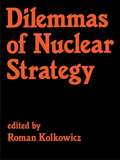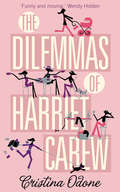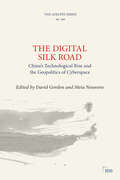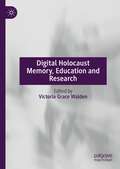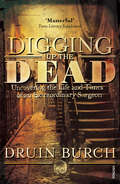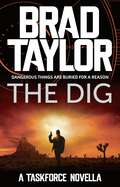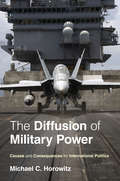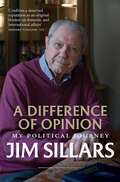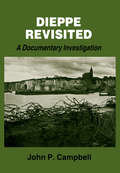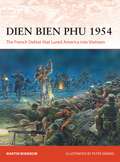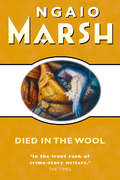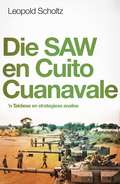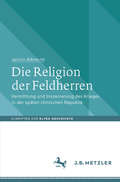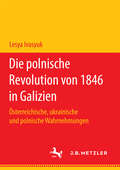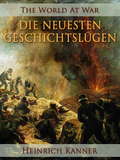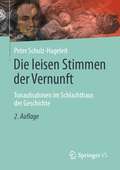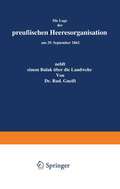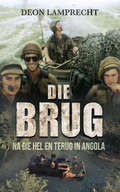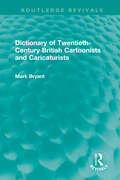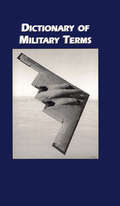- Table View
- List View
Dilemmas of Nuclear Strategy
by Roman KolkowiczThis volume reflects the research and discussions for the Bellagio Conference, with a spcial emphasis on the distinct perspective introduced by the Europeans on the issues of superpower strategic relations in general and on MAD and SDI in particular. Their views are shaped by concerns on how these broader issues might affect their own national security interests.
The Dilemmas of Harriet Carew
by Cristina OdoneHarriet Carew is the endearing heroine of Cristina Odone's popular weekly 'Daily Telegraph' column, 'Posh But Poor'. Based on the character from the column, 'The Dilemmas of Harriet Carew' is the story of her struggle to juggle family life, work and money.
The Digital Silk Road: China’s Technological Rise and the Geopolitics of Cyberspace (Adelphi series)
by David Gordon Meia NouwensConcerns about China’s ambitions to return to global centre stage as a great power have recently begun to focus on the Digital Silk Road (DSR), an umbrella term for various activities – commercial and diplomatic – of interest to the Chinese government in the cyber realm. Part of (or a spin-off from) the 2013 Belt and Road Initiative, by 2020 the DSR had become a focal point of China’s foreign policy. But the DSR remains ill-defined and poorly understood. At the heart of such concerns is not that Chinese technology companies are becoming globally competitive, but rather that Beijing could use them to ‘rewire’ the global digital architecture, from physical cables to code. Dominance by Chinese technology could shift global norms from a free cyber commons to competing systems of cyber sovereignty or cyber freedom. This Adelphi book brings together eight experts to examine the development of the DSR, explore its impact on economics, security and governance in recipient countries, and assess the broader impact on patterns of economic and technological dependence, on the emerging rules and norms of tech globalisation, and on global geopolitics and great-power relations. Beijing has grasped the opportunity to leverage the entrepreneurial strengths of its private tech sector to gain prominence in the world’s digital ecosystem. But the more interventionist Beijing becomes, the more Chinese firms will be seen as instruments of the state, and the greater the pushback against Chinese technology and the DSR may be. To achieve great-power status and global centrality, Beijing might ultimately need to change tack. How it innovates in further rolling out Chinese tech across the world, and what the DSR will then look like, will have far-reaching impacts on global economics, politics and security.
The Digital Silk Road: China’s Technological Rise and the Geopolitics of Cyberspace (Adelphi series)
Concerns about China’s ambitions to return to global centre stage as a great power have recently begun to focus on the Digital Silk Road (DSR), an umbrella term for various activities – commercial and diplomatic – of interest to the Chinese government in the cyber realm. Part of (or a spin-off from) the 2013 Belt and Road Initiative, by 2020 the DSR had become a focal point of China’s foreign policy. But the DSR remains ill-defined and poorly understood. At the heart of such concerns is not that Chinese technology companies are becoming globally competitive, but rather that Beijing could use them to ‘rewire’ the global digital architecture, from physical cables to code. Dominance by Chinese technology could shift global norms from a free cyber commons to competing systems of cyber sovereignty or cyber freedom. This Adelphi book brings together eight experts to examine the development of the DSR, explore its impact on economics, security and governance in recipient countries, and assess the broader impact on patterns of economic and technological dependence, on the emerging rules and norms of tech globalisation, and on global geopolitics and great-power relations. Beijing has grasped the opportunity to leverage the entrepreneurial strengths of its private tech sector to gain prominence in the world’s digital ecosystem. But the more interventionist Beijing becomes, the more Chinese firms will be seen as instruments of the state, and the greater the pushback against Chinese technology and the DSR may be. To achieve great-power status and global centrality, Beijing might ultimately need to change tack. How it innovates in further rolling out Chinese tech across the world, and what the DSR will then look like, will have far-reaching impacts on global economics, politics and security.
Digital Holocaust Memory, Education and Research
by Victoria Grace WaldenThis book explores the diverse range of practical and theoretical challenges and possibilities that digital technologies and platforms pose for Holocaust memory, education and research. From social media to virtual reality, 360-degree imaging to machine learning, there can be no doubt that digital media penetrate practice in these fields. As the Holocaust moves beyond living memory towards solely mediated memory, it is imperative that we pay critical attention to the way digital technologies are shaping public memory and education and research. Bringing together the voices of heritage and educational professionals, and academics from the arts and humanities and the social sciences, this interdisciplinary collection explores the practicalities of creating digital Holocaust projects, the educational value of such initiatives, and considers the extent to which digital technologies change the way we remember, learn about and research the Holocaust, thinking through issues such as ethics, embodiment, agency, community, and immersion. At its core, this volume interrogates the extent to which digital interventions in these fields mark an epochal shift in Holocaust memory, education and research, or whether they continue to be shaped by long-standing debates and guidelines developed in the broadcast era.
Digging Up the Dead: Uncovering the Life and Times of an Extraordinary Surgeon
by Druin BurchA tearaway young man from Norfolk, Astley Cooper (1768-1841) became the world's richest and most famous surgeon. Admired from afar by the Brontës and up close by his student Keats, his success was born of an appetite for bloody revolutions. He set up an international network of bodysnatchers, won the Royal Society's highest prize and boasted to Parliament that there was no one whose body he could not steal. Experimenting on his neighbours' corpses and the living bodies of their stolen pets, his discoveries were as great as his infamy. Caught up in the French Revolution, and in attempts to bring radical democracy to Britain, Cooper nevertheless rose to become surgeon to royals from the Prince Regent to Queen Victoria. Setting the past against his own reactions to autopsies and operations, hospitals and poetry, Burch's Digging Up the Dead is a riveting account of a world of gothic horror as well as fertile idealism.
The Dig: A gripping military thriller from ex-Special Forces Commander Brad Taylor (Taskforce Novella #4)
by Brad TaylorDangerous things are buried for a reason. The Taskforce – a highly clandestine Special Forces unit – is about to expose a conspiracy. Top operator, Pike Logan, has discovered more than Indian artefacts at an archaeological site in New Mexico. But exposing the conspiracy could lead to something much more treacherous. The Taskforce must tread carefully, otherwise they'll be buried alongside the desert's deadliest secrets. The Taskforce unearth a deadly conspiracy in this exhilarating novella, from New York Times bestselling author Brad Taylor. Praise for Brad Taylor: 'It's an excellent read, and I greatly enjoyed it' Nelson DeMille. 'Pike ranks right up there with Jason Bourne, Jack Reacher and Jack Bauer' John Lescroart. 'Logan is a tough, appealing hero you're sure to root for' Joseph Finder. 'Fresh plot, great actions, and Taylor clearly knows what he is writing about' Vince Flynn.
The Diffusion of Military Power: Causes and Consequences for International Politics
by Michael C. HorowitzThe Diffusion of Military Power examines how the financial and organizational challenges of adopting new methods of fighting wars can influence the international balance of power. Michael Horowitz argues that a state or actor wishing to adopt a military innovation must possess both the financial resources to buy or build the technology and the internal organizational capacity to accommodate any necessary changes in recruiting, training, or operations. How countries react to new innovations--and to other actors that do or don't adopt them--has profound implications for the global order and the likelihood of war. Horowitz looks at some of the most important military innovations throughout history, including the advent of the all-big-gun steel battleship, the development of aircraft carriers and nuclear weapons, and the use of suicide terror by nonstate actors. He shows how expensive innovations can favor wealthier, more powerful countries, but also how those same states often stumble when facing organizationally complicated innovations. Innovations requiring major upheavals in doctrine and organization can disadvantage the wealthiest states due to their bureaucratic inflexibility and weight the balance of power toward smaller and more nimble actors, making conflict more likely. This book provides vital insights into military innovations and their impact on U.S. foreign policy, warfare, and the distribution of power in the international system.
The Diffusion of Military Power: Causes and Consequences for International Politics
by Michael C. HorowitzThe Diffusion of Military Power examines how the financial and organizational challenges of adopting new methods of fighting wars can influence the international balance of power. Michael Horowitz argues that a state or actor wishing to adopt a military innovation must possess both the financial resources to buy or build the technology and the internal organizational capacity to accommodate any necessary changes in recruiting, training, or operations. How countries react to new innovations--and to other actors that do or don't adopt them--has profound implications for the global order and the likelihood of war. Horowitz looks at some of the most important military innovations throughout history, including the advent of the all-big-gun steel battleship, the development of aircraft carriers and nuclear weapons, and the use of suicide terror by nonstate actors. He shows how expensive innovations can favor wealthier, more powerful countries, but also how those same states often stumble when facing organizationally complicated innovations. Innovations requiring major upheavals in doctrine and organization can disadvantage the wealthiest states due to their bureaucratic inflexibility and weight the balance of power toward smaller and more nimble actors, making conflict more likely. This book provides vital insights into military innovations and their impact on U.S. foreign policy, warfare, and the distribution of power in the international system.
A Difference of Opinion: The Autobiography of Jim Sillars
by Jim SillarsJim Sillars as a working-class schoolboy was told by the Deputy Rector at Ayr Academy that he would end up a ‘common labourer’, and by the Rector that he would ‘make nothing of himself’. He went on to be elected an MP twice, reaching high levels of political leadership, and making a continuing high-profile contribution to public life and policy. During a 60-year career in politics he moved from being a Labour MP and staunch Unionist – known as the hammer of the Nats – to becoming a prominent member of the SNP. He won the Govan by-election for the SNP, controversially became a columnist for the Scottish Sun, and when he lost his seat in 1992 notoriously described Scots as ‘90-minute patriots’.His 33-year marriage to Margo MacDonald and her involvement in nationalist politics is covered in the book. Though he is still a member of the SNP, both he and Margo clashed repeatedly with the SNP leadership, and he is now a sharp critic of the SNP leader Nicola Sturgeon and what he describes as the SNP’s cult of personality.
Dieppe Revisited: A Documentary Investigation (Studies in Intelligence)
by John P. CampbellThis book reappraises the ill-fated raid named operation Jubilee, focusing on aspects such as naval and air operations in the Channel, signals, radar intelligence, agents and deception. It draws from official archives, both German and Allied. From these voluminous but fragmented records, many of which have been destroyed, classified or lost, the book aims to thread the evidence together.
Dieppe Revisited: A Documentary Investigation (Studies in Intelligence)
by John P. CampbellThis book reappraises the ill-fated raid named operation Jubilee, focusing on aspects such as naval and air operations in the Channel, signals, radar intelligence, agents and deception. It draws from official archives, both German and Allied. From these voluminous but fragmented records, many of which have been destroyed, classified or lost, the book aims to thread the evidence together.
Dien Bien Phu 1954: The French Defeat that Lured America into Vietnam (Campaign)
by Martin WindrowIn late 1953, the seventh year of France's war against the Viet Minh insurgency in its colony of Vietnam, the C-in-C, General Navarre, was encouraged to plant an 'air-ground base' in the Thai Highlands at Dien Bien Phu, to distract General Giap's Vietnamese People's Army from both Annam and the French northern heartland in the Red River Delta, and to protect the Laotian border. Elite French paratroopers captured Dien Bien Phu, which was reinforced between December 1953 and February 1954 with infantry and artillery, a squadron of tanks and one of fighter-bombers, to a strength of 10,000 men. Giap and the VPA General Staff accepted the challenge of a major positional battle; through a total mobilization of national resources, and with Chinese logistical help, they assembled a siege army of 58,000 regular troops, equipped for the first time with 105mm artillery and 37mm AA guns. Here, author Martin Windrow describes how from their first assaults on 13 March 1954, the battle quickly developed into a dramatic 56-day 'Stalingrad in the jungle' that drew the attention of the world.
Dien Bien Phu 1954: The French Defeat that Lured America into Vietnam (Campaign)
by Martin WindrowIn late 1953, the seventh year of France's war against the Viet Minh insurgency in its colony of Vietnam, the C-in-C, General Navarre, was encouraged to plant an 'air-ground base' in the Thai Highlands at Dien Bien Phu, to distract General Giap's Vietnamese People's Army from both Annam and the French northern heartland in the Red River Delta, and to protect the Laotian border. Elite French paratroopers captured Dien Bien Phu, which was reinforced between December 1953 and February 1954 with infantry and artillery, a squadron of tanks and one of fighter-bombers, to a strength of 10,000 men. Giap and the VPA General Staff accepted the challenge of a major positional battle; through a total mobilization of national resources, and with Chinese logistical help, they assembled a siege army of 58,000 regular troops, equipped for the first time with 105mm artillery and 37mm AA guns. Here, author Martin Windrow describes how from their first assaults on 13 March 1954, the battle quickly developed into a dramatic 56-day 'Stalingrad in the jungle' that drew the attention of the world.
Died in the Wool: Final Curtain; Swing, Brother, Swing (The Ngaio Marsh Collection #5)
by Ngaio MarshNgaio Marsh returns to her New Zealand roots to transplant the classic country house murder mystery to an upland sheep station on South Island – and produces one of her most exotic and intriguing novels.
Die SAW en Cuito Cuanaval: ’n Taktiese en strategiese analise
by Dr Leopold ScholtzIn 1987–1988 was die stowwerige Angolese dorpie Cuito Cuanavale die toneel van die laaste gevegte van die Grensoorlog. Sedertdien is dit die fokuspunt van ’n openbare debat oor wie eintlik hierdie oorlog gewen het.Die leierskorps van die Suid-Afrikaanse Weermag (SAW) hou vol hulle is nooit verslaan nie, terwyl die alliansie van die Angolese MPLA-regering, Kuba en Swapo beweer hulle het die SAW uit Angola en Suidwes-Afrika verdryf. Hulle glo voorts die SAW wou Cuito Cuanavale beset en as afspringplek gebruik om Luanda in te neem.Maar was Cuito Cuanavale ooit regtig ’n doelwit vir die Suid-Afrikaners? Dit is die vraag wat Leopold Scholtz vra wanneer hy onlangs gedeklassi-fiseerde dokumente in die weermagargief bestudeer en die taktiese en strategiese besluite ondersoek wat ’n bepalende rol in die ses groot veldslae van dié veldtog gespeel het.Sy kritiese ontleding wys hoe maklik propaganda en politiek in die pad van feite kan staan.
Die Religion der Feldherren: Vermittlung und Inszenierung des Krieges in der späten römischen Republik (Schriften zur Alten Geschichte)
by Janico AlbrechtIm Namen der Res Publica in den Krieg zu ziehen bedeutete für römische Feldherren nicht nur, das Heer zu kommandieren, es bedeutete auch, die Verantwortung für die Kommunikation mit den Göttern zu tragen. Janico Albrecht zeigt, dass neben dem Schlachtfeld auch die stadtrömische Heimatfront ein Ort für religiöse Inszenierungen des Krieges darstellte. Auch jenseits des Triumphs kam der Religion eine wichtige Rolle für die Vermittlung des fernen Kriegsgeschehens zu. Spätrepublikanische Feldherren wie Sulla, Pompeius und Caesar werden als religiöse Akteure unter Gesichtspunkten wie dem Eingehen auf unterschiedliche Publika sowie der Fortführung ihrer Ansprüche in der Memoirenliteratur untersucht. Ihre Inszenierungen göttlicher Nähe und religiöser Autorität spielten in der antiken Erinnerung oft eine wichtigere Rolle als ihre militärischen Leistungen und trugen entscheidend zur literarisch fassbaren Wahrnehmung des Krieges in Rom bei.
Die polnische Revolution von 1846 in Galizien: Österreichische, ukrainische und polnische Wahrnehmungen
by Lesya IvasyukLesya Ivasyuk wirft zum ersten Mal einen umfassenden und interdisziplinären Blick auf die polnische Revolution von 1846. Sie zeigt auf, dass dieses 171 Jahre zurückliegende Ereignis – trotz seines geographisch gesehen engen Rahmens – ein Vorbote des „Völkerfrühlings“ war und zahlreiche Modernisierungsversuche verursachte. Der Ausbruch der Revolution in der österreichischen Randprovinz Galizien wühlte ganz Europa auf. Zum wiederholten Mal stand die polnische Frage auf der Tagesordnung, wobei die Rolle der Bauern entscheidend war. Die österreichische Monarchie wurde wegen ihrer Vorgehensweise bei der Niederschlagung zur Zielscheibe der internationalen Kritik. Die von der Autorin herangezogene und von ihr begrifflich erweiterte historische Hermeneutik ermöglichte qualitativ neue Interpretationen dieses Ereignisses.
Die neuesten Geschichtslügen (The World At War)
by Heinrich KannerHeinrich Kanner (* 9. November 1864 in Galați; † 15. Februar 1930 in Wien) war ein österreichischer Politiker, Journalist und Zeitungsherausgeber. Noch während des Weltkrieges begann Heinrich Kanner seine Recherche nach der Kriegsschuldfrage. Zu diesem Zwecke interviewte er während des Krieges eine Reihe von prominenten Vertretern des öffentlichen Lebens darunter auch mehrfach Leon von Bilinski, der von 1912 bis 1915 gemeinsamer Finanzminister der Donaumonarchie war und an den entscheidenden Sitzungen und Besprechungen über die Außenpolitik in dieser Zeit teilgenommen hat. Bilinski bezeugte in den Gesprächen mit Kanner, dass Kaiser Franz Joseph seit dem Frühjahr 1913 fest entschlossen war, nötigenfalls eine Aktion am Balkan zu genehmigen und zwar unbeschadet des Risikos eines Zusammenstoßes mit Russland. (Auszug aus Wikipedia)
Die leisen Stimmen der Vernunft: Tonaufnahmen im Schlachthaus der Geschichte
by Peter Schulz-HageleitGeschichte als Abfolge von Massentötungen aller Art und – im Gegensatz dazu – Geschichte als Konzert von leisen Stimmen, die den Frieden beschwören und Vernunft anmahnen: das sind zwei Leitmotive des Buches, die in verschiedenen Inhaltsvariationen thematisiert werden. Dabei finden die grauenhaften Tatsachen der Geschichte ebenso Berücksichtigung wie die kognitiv-emotionale Schwierigkeit, im historisch-politischen Schlachthaus-Geschehen (Kriege, Völkermorde) nicht die Augen zu verschließen, sondern vielmehr standzuhalten und existenziell für eine bessere Welt einzutreten.Was zur Zeit der ersten Auflage des Buches (2006) weit entfernt von realgeschichtlichen Möglichkeiten zu liegen schien, ein imperialistischer Eroberungskrieg, ist seit Februar 2022 bedrückende Wirklichkeit. Die veränderte weltpolitische Konstellation entwertet die früheren Reflexionen und Recherchen nicht, sondern taucht die Befunde in ein noch grelleres Licht.Das Buch wendet sich nicht nur an Personen, die Geschichte professionell erarbeiten und vermitteln, sondern an alle, die im Verhältnis zur Geschichte, wie es medienwirksam präsentiert und zelebriert wird, Probleme sehen.
Die Brug: Na die hel en terug in Angola
by Deon LamprechtIn vergeelde foto’s van drie dekades gelede staan oop gesigseuns vol bravade voor hul Ratel-gevegsvoertuie. Hierdie dienspligtiges van 61 Gemeganiseerde Bataljon Groep staan aan die begin van hul reis diep in Angola in om vir volk en vaderland te gaan veg.In ’n bloedige geveg op Valentynsdag 1988 en in die doods akker by Tumpo sou hul jeugdige onskuld egter sneuwel. In die hitte van die gevegte kom die besef: Nou gaan dit nie oor ideologie nie, maar om oorlewing.Ná die oorlog gaan die lewe voort, maar die vrae en geestelike letsels wyk nie. In 2018 keer ’n groep van dié ouddienspligtiges terug na Cuito Cuanavale op soek na afsluiting – en om die wrak te vind van die Ratel waarin ’n makker op die laaste dag van die oorlog gesterf het.Die Brug vertel van hul reis van jong man na veteraan en gee ook ’n stem aan die vroue in hul lewe. Dit is ’n verhaal van ontnugtering, maar ook van trotse kameraderie en genesing.
Dictionary of Twentieth-Century British Cartoonists and Caricaturists (Routledge Revivals)
by Mark BryantBritish cartoonists and caricaturists are renowned worldwide. Originally published in 2000, this indispensable handbook offers a unique ‘who’s who’ of all the major artists working in Britain in the twentieth century and contains nearly 500 entries. Extensively illustrated, the book provides information on the work of artists such as Steve Bell, Gerald Scarfe, Posy Simmonds, Ronald Searle, Trog, mac and Larry as well as such past masters as David Low, Vicky, H. M. Bateman, Illingworth, Heath Robinson and more. The dictionary concentrates primarily on political cartoonists, caricaturists and joke or ‘gag’ cartoonists, actively working for the main Fleet Street national dailies and weeklies from 1900 to 1995. Each entry is cross-referenced and provides a concise biographical outline with an account of the artist’s style, influences and preferred medium. Where relevant the entry includes suggestions for further reading and notes solo exhibitions, books illustrated and works held in public collections. The Dictionary of Twentieth-Century British Cartoonists and Caricaturists offers an insight into the lives of satirical artists working during a century that provoked cartoonists and caricaturists to a pitch of comic and artistic invention that has rarely been matched.
Dictionary of Twentieth-Century British Cartoonists and Caricaturists (Routledge Revivals)
by Mark BryantBritish cartoonists and caricaturists are renowned worldwide. Originally published in 2000, this indispensable handbook offers a unique ‘who’s who’ of all the major artists working in Britain in the twentieth century and contains nearly 500 entries. Extensively illustrated, the book provides information on the work of artists such as Steve Bell, Gerald Scarfe, Posy Simmonds, Ronald Searle, Trog, mac and Larry as well as such past masters as David Low, Vicky, H. M. Bateman, Illingworth, Heath Robinson and more. The dictionary concentrates primarily on political cartoonists, caricaturists and joke or ‘gag’ cartoonists, actively working for the main Fleet Street national dailies and weeklies from 1900 to 1995. Each entry is cross-referenced and provides a concise biographical outline with an account of the artist’s style, influences and preferred medium. Where relevant the entry includes suggestions for further reading and notes solo exhibitions, books illustrated and works held in public collections. The Dictionary of Twentieth-Century British Cartoonists and Caricaturists offers an insight into the lives of satirical artists working during a century that provoked cartoonists and caricaturists to a pitch of comic and artistic invention that has rarely been matched.
Dictionary of Military Terms
by Richard BowyerFirst Published in 2000. Routledge is an imprint of Taylor & Francis, an informa company.
